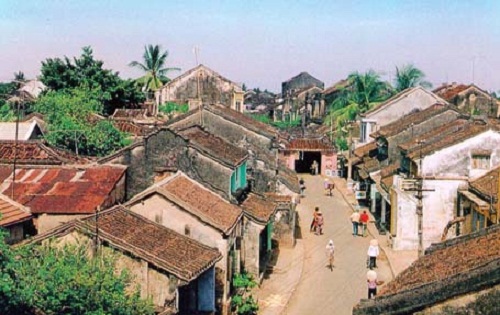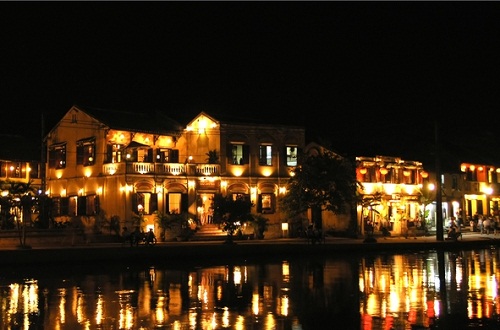- Vietnam Overview
- Main Cities in Vietnam
- Regions in Vietnam
- Other Cities in Vietnam
- Getting to Vietnam
- Getting Around Vietnam
- Language in Vietnam
- Education in Vietnam
- Vietnam Activities
- Vietnam Attractions
- Vietnam Money & Shopping
- Eating and Drinking in Vietnam
- Dress Code in Vietnam
- Gift Giving in Vietnam
- Public Behavior in Vietnam
- Art Performance
- Custom and Habits
Hoi An ancient town
Hoi An ancient town is a very famous place of Vietnam where could remain such a cristine ancient beauty after nearly 300 circles of the four seasons.

Location
Located on the banks of the poetic Thu Bon River, in central Quang Nam province, 30 kilometers south of Da Nang, Hoi An ancient town is an Eastern oriental classic captivation. With the strategic location on the banks of the great river, with one seaside border (East), it used to be one of the major trading centers in Southeast Asia during the 16th century due to the early western trader occupying period.
History
Hoi An has been through a few centuries of history, but still remains as in the very first days of its being born. Its two main historical landmarks are the occupying of the Japanese & Chinese, and the Western (Dutch and Spanish) during the 16th and 17th centuries. During the period of the China trade, the town was called Hai Pho (Sea Town) in Vietnamese. Originally Hai Pho was a divided town, because across the "Japanese Bridge", it used to be the Japanese settlement (16th-17th century). Then it was known to the French and Spanish as Faifo, a major international port city. Thanks to these days, the foreign comprehensively possitive and special pastimes and culture had made deep influences on the today's Hoi An.
Natural conditions
Whoever coming to Hoi An could not deny that it is favored by nature. The weather here is typically tropical. Hoi An is comparatively warm especially during the entire year, and can be classified into two main categories namely wet and dry seasons. The daily temperature rises beyond 70o F reaching mid 60o F especially during the nighttime. Travellers should really take a journey here and enjoy Hoi An weather!
Culture
Architecture
Coming here, tourists can see a series of old-architectured lanes and houses with nearly 100% cristinely left from their initial buildings with mossgrown walls, deeply plain roofs, old furniture in their cristine past arrangment etc. Hoi An is fortunate to be a cultural crossroads of the Cham culture in the very first southward expansion of Dai Viet (the Vietnamese nation more than 5 centuries ago encroaching on the Indianized Kingdom of Champa, which covered much of what is now central Vietnam), the Asian (Japanese, Chinese, Indian), and the Western ones during their trading here in the 16th century. These diverse cultural influences remain visible today. Colourful guildhalls, founded by ethnic Chinese from Guangdong and Fujian provinces, stand quietly, a testament to the town's trading roots.
While Hoi An's old-fashioned charm is always visible, on the 14th of every lunar month modernity takes another step back. Most premium oriental and western style of architecture meet together here, making a unique ancient Hoi An, absorbing all tourists who are eager for classic beauty! Even you are not classic styled, you still want to see by yourself how a lively ancient world can cristinely survive in this new modern and high-tech era!
Festivals
Lanterns
Tourists should not miss some of the great festivals of Hoi An, among which is Full Moon Festival, held on the 14th of every lunar month, one night before the full moon, when the Old Town becomes even more festive than usual, active and marvellously decorated with colorful lights and lamps along every lane. Another one is the Mid-Autumn Festival - held on the 14th of the August lunar month. Last but not least, the "lantern festival", the most enchanting and special one of Hoi An, which is typically demonstrated with all colorful hanging cloth and paper lanterns on the 15th of every lunar month switched on altogether while all electrical equipment is off, leaving the Old Quarter bathed in the warm glow of colored silk, glass and paper lanterns.. A sparkling, romantic and mysterious view is opened, stimulating anybody’s curiosity and eye feed!
Religion
The 14th day of the lunar month is a Buddhist day of worship. Hoi An residents place offerings of food and incense on their ancestral altars and visit one of Hoi An's many pagodas. The scent of incense and the sounds of people singing add to the town's enchanted atmosphere. Visitors will get a rare glimpse into another era – the very far away period of our ancestors, and discovering it themselves.
Specialties
Hoi An’s delicacies are plentiful and particularly tasty and cheap. Let’s take an example, one of the most popular one - Cao lầu, a dish of rice noodles somehow closer in texture to pasta. What is its secret? It is the water used to make it, being collected from a special well in the city. The noodles are topped with slices of roast pork, dough fritters, and lots of fresh herbs and veggies. I think you should try one of these, or else you will soon regret! Let’s see, you are sitting on stools, eating a bowl of Cao Lau with wooden chopsticks, and sipping the ice cold "White Coffee with vinamilk"! Oh, this is really an interesting adventure!
Where to go and What to see?
Since Hoi An is an old Town, its places of interest are of full historically classical meaning and image. Hoi An symbol, the most popular remnant is the Japanese Covered Bridge (Chua Cau or Lai Vien Kieu), on the west end of Tran Phu Street. The bridge was constructed in the early 1600's by the Japanese community. Tourists should spend time on visiting Quan Cong Temple, Musium of Culture… Many ancient style - oriented architects come here to have a direct look into the ancient houses of the town, among which are Phung Hung House, just west of the Japanese Bridge, Quan Thang House, or Tan Ky House. The design of the houses show how local architecture incorporated Japanese and Chinese influences. Cantonese Assembly Hall (Quang Dong), has a calm courtyard with ornate statuary. You could take a peek at the half-hidden back yard and its kitschy pastel dragon statues. Hokien (Fujian) Meeting Hall (Phuc Kien) and Chinese All-Community Meeting Hall (Trieu Chau), are also spanning the block. If you are Buddhist, there are a lot of pagodas to visit. Ong Pagoda, Quan Am Phat Tu Minh Huong Pagoda, etc. are premium places to get in.
Today, Hoi An is also known as a shopping paradise that attracts tourists towards its wonderful souvenirs, handicrafts, antique pieces, silk materials and art paintings, and so on.

A Hoi An with colorful lanterned nights, a Hoi An with cristinely old plain houses and special mysterious cultural elements, and a HoiAn with the Etiquette & culturally hospitable and friendly people are warmly welcoming you! Are you ready to take a culture discovery journey?

